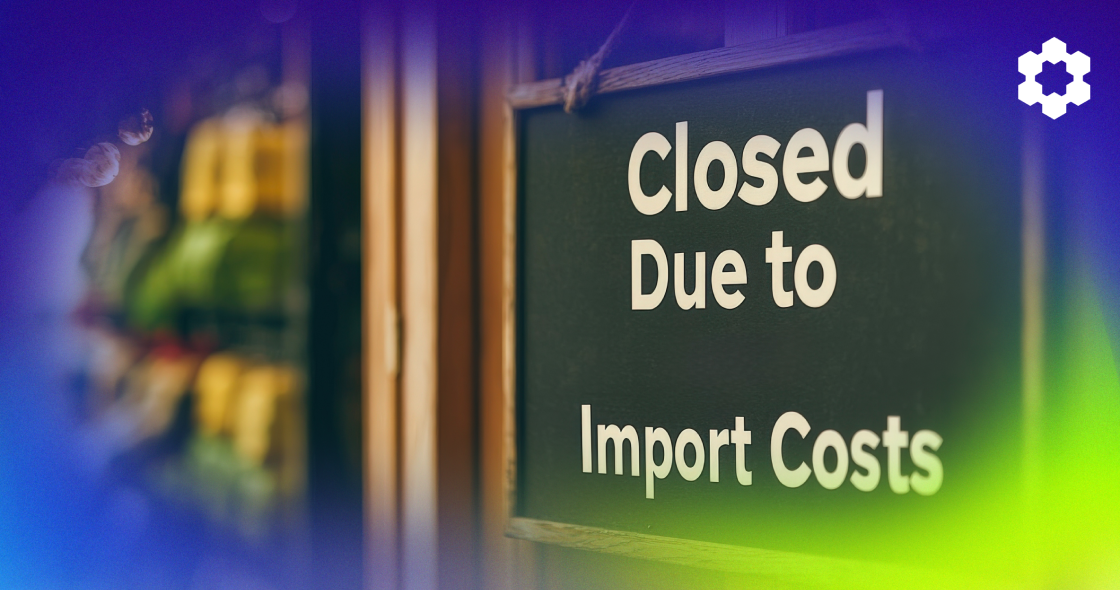Top Amazon FBA News This Week
This week’s Amazon seller updates roundup opens with a major shift in international commerce that could have far-reaching consequences for sellers on the platform.
- Tariff Hikes Strain Chinese Sellers and Prompt Amazon to Cancel Orders: President Trump’s decision to raise China import tariffs to 145% is pushing many Chinese Amazon sellers to consider raising prices or exiting the US market. In response, Amazon has reportedly canceled orders from suppliers in China and Southeast Asia to avoid rising costs, leaving vendors stuck with unsellable inventory and intensifying supply chain uncertainty.
- Amazon Introduces AI Model That Understands User Tone: Amazon unveiled “Nova Sonic,” a new AI model designed for natural voice-to-voice conversations. Integrated with its next-gen Alexa, this tool aims to power advanced AI agents that can take actions on behalf of users, reflecting Amazon’s broader investment in conversational AI.
- Amazon Air Shifts to Larger Aircraft and Third-Party Cargo: Amazon’s in-house cargo airline is reducing short-haul routes in favor of larger aircraft and multiple hubs. This strategic shift supports its regionalized fulfillment model and expands capabilities for third-party bulk shipments, signaling a stronger logistics focus beyond internal needs.
Taken together, these updates paint a portrait of an Amazon in transition—where global trade tensions, technological innovation, and shifting logistics strategies are changing how sellers operate and compete on the platform.
Sellers Scramble Amid Soaring Trump Tariffs and Sudden Inventory Cancellations
A wave of disruption is hitting the Amazon seller ecosystem as soaring China import tariffs collide with unexpected inventory order cancellations, forcing sellers to rethink their pricing, logistics, and go-to-market strategies in real time.
A Tidal Wave of Tariff Pressure
In a move that has rocked sellers across borders, President Donald Trump announced a sharp increase in tariffs on Chinese imports to 145%. For the more than 100,000 Amazon businesses based in Shenzhen, China—a region responsible for over $35 billion in annual Amazon revenue—this isn’t just a tax hike; it’s a financial earthquake, according to Wang Xin, the head of the Shenzhen Cross-Border E-Commerce Association.
- Rising Costs: Tariffs are pushing product costs dramatically higher. In a statement to Reuters, one seller cited a $3 children’s toy that will now cost $7 to produce post-tariff—necessitating a 20–50% price increase just to stay afloat.
- Shrinking Margins: Advertising budgets are being slashed, with sellers like Dave Fong cutting back on US ad spend (formerly 40% of revenue) and redirecting resources to markets like Europe and Canada.
- Market Exodus: Of five Shenzhen-based sellers interviewed by Reuters, two have already decided to leave the US market. Others are watching inventory levels closely and scaling back investment in new product development.
Wang Xin summed up the sentiment: “This is truly an unprecedented blow.” Logistics complications and customs delays further complicate the outlook.
Amazon’s Drastic Response: Canceled Orders and Unanswered Questions
In a parallel shock to sellers, Bloomberg reported that Amazon has abruptly canceled large inventory orders from China and Southeast Asia, including products like scooters, air conditioners, and beach chairs.
The cancellations occurred without clear explanation—some described as sent “in error”—and notably before Trump’s official tariff announcement.
- Vendors Left Hanging: One vendor was left responsible for $500,000 worth of inventory after their order was canceled post-manufacturing. With no recourse through Amazon, the vendor is now scrambling to offload products elsewhere.
- Tariff Avoidance or Strategic Shift?: Insiders believe the move was Amazon’s preemptive strategy to avoid footing the rising tariff bill. Because Amazon often acts as the “importer,” they bear direct costs for bulk shipments from factories to US warehouses.
- No Communication, No Compensation: Vendors report having no prior notice or explanation—facing unprecedented financial strain with little support or transparency from the ecomm giant.
Scott Miller, a former Amazon vendor manager, put it plainly: “Amazon really holds all of the cards.” Many vendors are now reevaluating their dependence on Amazon or considering deals with alternative retailers.
Maximize your Amazon revenue with our 1P and 3P Reimbursements guide. Learn how to get back what you’re owed under Amazon’s evolving policies through proven strategies for ongoing recovery. Download your free guide now.
Trump Tariffs: China Key Impacts
- Import product prices may rise by 20–50% as sellers adjust for increased costs.
- Smaller and medium-sized businesses may find themselves priced out of the US market.
- Those dependent on Amazon logistics or vendor terms face increased unpredictability and financial risk.
All things considered, these developments mark a pivotal moment for Amazon 1P vendors and 3P sellers—particularly those dependent on Chinese manufacturing or Amazon’s internal supply chain infrastructure. In a global economy where policy and platform decisions collide, resilience and adaptability are more critical than ever.
Amazon Launches New AI Voice Model
Amazon continues to push the envelope in AI technology with Nova Sonic, an AI model that revolutionizes voice interactions by understanding both the words and the tone in which they are spoken. Coupled with the recent rollout of the “Buy for Me” feature, this technology is reshaping how users interact with AI and shop online, making processes faster and more seamless for both customers and businesses alike.
Nova Sonic: A Breakthrough in Voice AI
At the heart of Amazon’s new AI advancements is Nova Sonic, a powerful new model that integrates speech understanding and generation into a single system. This model is designed to enhance voice interactions by interpreting the tone, inflection, and pacing of speech—nuances that traditional AI voice systems often overlook.
- Human-Like Conversations: With Nova Sonic, Amazon aims to make voice interactions more natural by responding based on not just the words spoken, but how they’re spoken. For instance, if a user expresses concern or hesitation, the AI will adapt its tone to reassure them, making conversations feel more authentic.
- Speed and Efficiency: Unlike traditional systems that convert speech to text and then generate a response, Nova Sonic speeds up the process by using a direct speech-to-speech model, cutting down on delays and providing a quicker, more natural exchange. This technology is already powering Alexa’s next-gen capabilities, allowing for more nuanced conversations.
For businesses, the implications are clear:
- Voice Search Optimization: As AI becomes better at understanding natural language, sellers should focus on optimizing their product listings for voice search. Understanding how customers speak (in tone, style, and cadence) will be crucial in ensuring your products are discoverable in a voice-driven environment.
- AI-Powered Customer Service: With Nova Sonic, sellers can also improve their customer service operations by implementing AI-driven customer service tools that respond naturally and efficiently, reducing the need for live agents while still maintaining a human-like experience.
In conclusion, Amazon Nova Sonic is setting the stage for a more integrated and intelligent ecommerce environment. Brands that adapt to these changes by optimizing for voice search and embracing AI-driven customer service will be best positioned for success in this new landscape.
Unlock the future of ecommerce with our AI Revolution white paper. Discover how leading Amazon sellers leverage AI for personalization, product research, and advertising optimization. Download your free guide now and start integrating AI.
Amazon Air Scales Up, Consolidates Routes
Amazon Air, the retailer’s in-house cargo airline, is undergoing a major transformation—and sellers should take note. With a stronger focus on widebody aircraft, third-party shipping, and US-based logistics, Amazon is building an air cargo empire that’s evolving far beyond parcel delivery for Prime customers.
From Parcels to Pallets: Amazon Air’s New Mission
Over the past two years, Amazon has shifted its air cargo model to better align with its regionalized fulfillment strategy and emerging third-party logistics services. Key changes include:
- More Widebody Aircraft: Amazon Air has added ten Airbus A330-300 freighters, offering 17% more weight capacity and 6% more volume than the Boeing 767s that previously dominated the fleet. Now, over 75% of Amazon’s air cargo capacity is on widebody planes.
- Fewer Small Planes, More Hubs: Amazon has dropped smaller turboprop aircraft and pulled operations from five airports. Instead, it’s consolidating at larger hubs like CVG (Cincinnati/Northern Kentucky), San Bernardino in California, and Ft. Worth Alliance in Texas.
- Third-Party Cargo Push: With this extra capacity, Amazon Air is now officially offering air cargo services to outside businesses—including logistics companies, online retailers, and postal carriers. Sellers may not be directly affected yet, but Amazon’s entry into the broader freight market could change the competitive landscape.
Less Flying, More Trucking: Why Amazon Is Going Regional
According to a report by DePaul University, Amazon has doubled down on regional fulfillment, reducing short-haul air routes in favor of ground transport for mid-range distances. For context:
- Flights under 400 miles now account for just 5.1% of Amazon Air’s total in the US, compared to over 10% two years ago.
- The company is instead placing inventory closer to end customers, favoring regional trucking to fulfill one-day and two-day delivery promises.
- Amazon’s heavy investment in late-night flights—with 41% of flights now operating between 10 p.m. and 6 a.m.—means early morning deliveries are more feasible, even without short-haul air support.
For sellers, this means faster delivery expectations—but also greater pressure to get inventory into regional fulfillment centers (FCs) ahead of time.
Scaling Back in Europe, Doubling Down in the US
While Amazon Air’s global footprint is growing modestly (up 13% in capacity), nearly all that growth is in the US. European operations have been reduced by two-thirds since 2022:
- Amazon now runs just 12 daily European flights (none on Saturdays), all point-to-point routes via ASL Ireland using 737-800s.
- Rather than build a European superhub, Amazon is concentrating flights in the “Golden Triangle” (Amsterdam–Frankfurt–Paris), where two-thirds of European freight flows.
For international sellers or those shipping from Europe to the US, this means fewer direct air options and more reliance on traditional carriers or sea freight—unless Amazon expands again in the future.
While much of this news centers on Amazon’s logistics backbone, it has ripple effects for marketplace sellers and brand owners.
- Expect More Competition from Amazon Logistics: Amazon’s third-party air cargo service could eventually open new programs for sellers—or create more competition with services like UPS, FedEx, and DHL.
- Faster Delivery, Higher Expectations: With more inventory positioned regionally and overnight flights increasing, Prime delivery windows will continue to tighten, raising the bar for FBA sellers.
- Less Reliance on Air for Short Distances: Don’t count on air freight for inventory repositioning within the US—Amazon is relying on trucks more than ever.
Overall, Amazon air cargo is no longer just the quiet engine behind Prime—it’s becoming a heavyweight in global logistics. Sellers who understand the shifting winds of air freight and fulfillment will be better equipped to stay competitive and responsive in an increasingly competitive marketplace.
Other Amazon Seller Updates This Week
- Third-Party Sellers Drive 60% of Amazon’s Ecommerce Sales
According to Amazon’s US Small Business Empowerment Report, independent sellers now account for 60% of total sales. SMBs sold over 4.1 billion products last year, with rural sellers seeing more than 40% year-over-year growth. - Japan: Last Major Amazon Marketplace Dominated by Local Sellers
Japan stands out as the only Amazon marketplace where a majority (54%) of active sellers are local businesses, per Marketplace Pulse. In contrast, local representation has dwindled in markets like Canada (4%) and the US (34%), where Chinese and cross-border sellers now dominate. - Amazon Deploys 750,000 Robots in Operations Network
Amazon highlighted its growing use of robotics with more than 750,000 units deployed across fulfillment centers. The newest facility in Shreveport, LA features eight robotic systems using AWS cloud tech to boost efficiency. However, many sellers have responded with skepticism and frustration, pointing out unresolved issues like inventory discrepancies, shipment check-in errors, and a perceived lack of seller support. For some, this investment in automation feels disconnected from the daily challenges sellers face. - Amazon Eyes $15B Warehouse Expansion Across US
Amazon is reportedly exploring a $15 billion plan to build around 80 new logistics facilities in both urban and rural areas across the US, as part of early-stage discussions with capital partners. - Amazon Electric Delivery Vehicles Go Global as Part of Net-Zero Emissions Goal
Amazon is rolling out electric delivery vehicles worldwide as part of its goal for net-zero carbon emissions by 2040, with the promise of cleaner air, quieter deliveries, and reduced noise pollution, though some sellers are skeptical, urging Amazon to prioritize addressing ongoing issues like inventory loss, FBA inefficiencies, and support improvements before further investments in electric vehicles.
Thriving Amid Amazon Tariffs, AI, and Logistics Changes
This week’s Amazon seller updates—from tariff-driven turmoil to AI innovation and air cargo realignment—signal big changes ahead. To stay competitive, take proactive steps to adapt:
- Diversify Your Supply Chain: Don’t rely solely on China-based manufacturing. Explore sourcing options in Mexico, India, or Southeast Asia to reduce tariff exposure and shipping risk.
- Build Contingency Plans for Vendor Disruption: If you rely on Amazon as a vendor, prepare for sudden changes in order volume or cancellations. Maintain diversified sales channels and establish direct relationships with alternative buyers or retailers.
- Embrace Voice Search and Conversational AI: Optimize product listings for natural language queries and consider integrating AI-powered customer service to align with evolving shopper expectations.
- Plan Ahead for Regional Fulfillment: Improve your chances of optimal regional placement by forecasting demand accurately and sending inventory in early to help Amazon distribute your stock more effectively.
- Monitor New 3P Logistics Opportunities: Keep an eye on Amazon’s expansion into third-party freight. This could present new options—or new competition—for how you ship and scale.
For nearly four years, we’ve kept sellers informed with our Amazon Sellers Newsletter, publishing over 200 issues packed with policy changes, announcements, and community events. Subscribe or share with your team to get these insights delivered weekly.




